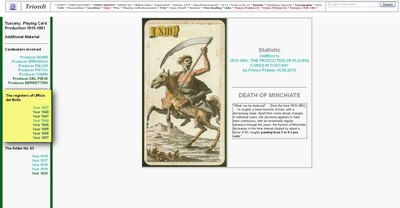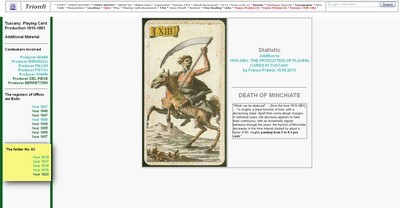Introduction
In a few notes of this series, I could already provide some new information on playing cards in Tuscany in the 19th century; one in particular contained information on the local card production in the years 1839 and 1841.(1) The present case, however, is different from all the similar ones: never had I described so many records together, practically the complete card production of the Grand Duchy of Tuscany from 1815 to 1861, for about half a century.
The archive group under examination is “Amministrazione Generale del Registro e Aziende riunite”, and has a unusual history in the Archivio di Stato di Firenze. In 1989 the ASF was moved from the renowned Uffizi into a new building near Porta alla Croce. This was the occurrence that allowed the archive group under examination to come to light, after a long time. Earlier on, it was impossible to study it, because it was stored in a completely disordered way, and in some inaccessible areas.
This whole archive group contains more than three thousand items; even in the new location, it has been for years without any suitable order and inventory. Only thanks to a special authorization by the responsible archivist of the section, Loredana Maccabruni, who has also compiled an unpublished inventory of this archive group, I could study a selection of these documents.
My attention has been first of all focused into one sequence of official yearly registers, precisely dedicated to the production of the Florentine cardmakers; later on, I could confirm this information with data recorded in other registers, as will be indicated below.
1 – Giornali dei conti aperti dei Fabbricanti delle carte da giuoco
This is a whole sequence of official registers kept by the state administration for controlling the playing card production; it belongs to the series: ASF, Amministrazione Generale del Registro e Aziende riunite, Ufficio del Bollo Straordinario e Azienda delle Carte da giuoco.
All the members of this sequence are indicated in the table below, in which we find for every register the present number in the series in the first column; its original number in the particular sequence indicated, as we can still see written on the books, in the second column; the corresponding years in the third column.
Giornali dei conti aperti dei Fabbricanti delle carte da giuoco

Most of the information reported and discussed below derives from all these registers.
1.1 - Kinds of playing cards
In most of the registers listed, the records of the Florentine card production in the time interval considered are arranged on seven columns, corresponding to seven different kinds of card packs. In some cases, however, a few of these columns are empty, or missing.
The order of the seven columns, using P for Piccole or small, G for Grandi or large, and M for Minchiate, and moreover indicating each pack with the corresponding number of cards, is usually as follows:

For the sake of simplicity, it may be better to see the seven columns as six devoted to “ordinary” cards, and the seventh to Minchiate. Minchiate production can be considered apart, also for the different kind of paper used, with thicker sheets.
The six different kinds of ordinary cards in their turn can be seen as a pair of triplets: actually, the different packs were only three, but each of them was produced either in the Piccole or Grandi formats, small or large version.
On the other hand, the three different kinds were distinguished on the basis of the number of cards composing the pack, 32, 40, or 52. This distinction is not present for all years, similarly complete, and in the same order. I have tried to use the same order of the columns in copying the records.
A problem derives from the indication of these packs. Differently from what has been found in Lucca, (2) the number of cards in a given pack is usually not specified explicitly. The 40-card pack is indicated as Quadrigliati, which was the most used game of the Tresette family.
It is fairly certain that the packs indicated as Picchetti or Picchetto were complete 52-card packs. I know that piquet was played with the 32-card pack (and in Lucca the name was indeed associated with those packs),(2) but with the same 32-card pack was played Écarté, the name that was currently used to indicate the 32-card pack in these registers.
It is not mentioned whether the cardmakers introduced further distinguishing features, but it is likely that differences existed between the various packs – including minor ones among the “same” packs produced by different makers.
The most immediate way to use these records is to deduce the whole yearly production, thus considering the cardmakers together, in groups listed year after year. This I am reporting firstly, but later on the production of each cardmaker will be considered too.
It must be remembered that all the following tables correspond to nothing else than a small part of the whole information present in the registers, where the individual visits of the cardmakers to the office are recorded day after day with the amount of watermarked paper received and the corresponding finished packs submitted for being stamped.
1.2 - The yearly production of the various playing cards
In the registers listed above we find the production of the individual cardmakers recorded. We can thus obtain the yearly production of the various cards by all cardmakers, as reported in the following table. Numbers in brackets derive from other sources, indicated in the following.
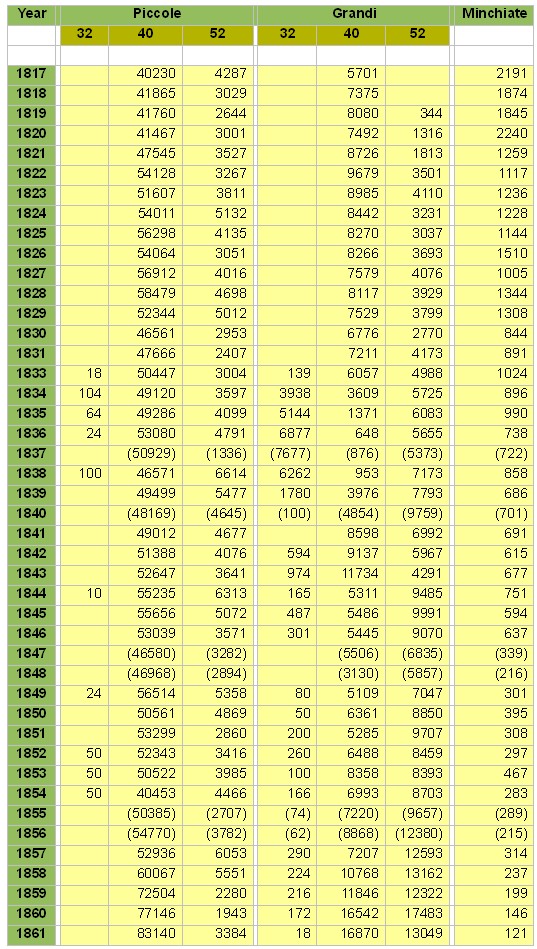
1.3 - The total production and the Minchiate fraction
It is possible to find the grand total of the card production in Florence, as reported in the second column of the following table; again, the numbers within brackets have been obtained from other registers, described in the following sections. Except for minor variations, or some discrepant value that may require a specific explanation, we see that usually the total yearly production was of roughly seventy thousand packs, with a marked increase for the last years.
It may be of interest to examine the fraction of Minchiate among the various packs produced, listed in the third column of the table.

As a matter of fact, several decades before, Minchiate had become a fashion game in France and Germany, in addition to what was occurring in the most exclusive circles and academies in several Italian towns, to begin with Rome.
Nevertheless, one should bear in mind that this was nothing else than the most traditional of the Florentine card games, and that precisely in Florence this game has been played for about four centuries. It is thus a useful occurrence that now we can directly measure its popularity through the production of these special packs.
What can be deduced from the third column of the table is roughly a linear function of time, with a decreasing slope. Apart from some abrupt changes in individual years, the decrease appears to have been continuous, with an essentially regular behaviour through the years: the fraction of Minchiate decreases in the time interval studied by about a factor of 50, roughly passing from 5 to 0.1 per cent.
It must be noted that the above comparison does not take the various card games into account. The pack of Minchiate was only used for the traditional game; the other packs could in principle be used for many kinds of card games. We can imagine that a given new game came into fashion, up to entail the multiplication of the usual playing cards: even if the players of Minchiate remained the same, their percentage was thus diminishing.
Such seems to be the case, in particular, in the very last years under study: by then, the amount of ordinary cards increased so much that the ratio of Minchiate to the total number of packs decreased more rapidly than their absolute values. As a matter of fact, the above mentioned factor of 50 for the ratios becomes lower than 20 if one directly considers the amount of Minchiate packs produced and stamped.
1.4 - Cardmakers involved
The time interval under examination is relatively long, so that we can expect to find several cardmakers active. Actually, their number is not as great as we could imagine, except for the first years of the interval, when the local situation still echoed the changes of rules and control introduced by the several administrations in charge after the French occupation of the initial 19th century.
A few cardmakers, who were active in previous years had interrupted their activity at about this time, or were active for the last months, such as Adriano ZANOBETTI, Giovan Battista AGOSTINI, Lorenzo CAPIGATTI, Vincenzio BARAGIOLI (since June 1818 we find Giuseppe with this family name); Carlo VANNINI had left the job in December 1814.
Let us see the situation of the local cardmakers in 1817.(3)

Giovanni PISTOJ was initially the leader of the group of five cardmakers active in the same workshop. In May 1818, Luigi MAURY moves his workshop to Leghorn (= Livorno). Cosimo ADAMI begins in January 1827 together with Gaetano DEL PIEVE, then he continues alone since January 1831. After June 1830, Zanobi FALUGI disappears and only Pasquale remains.
Let us jump to the year 1836, when the situation is greatly simplified, as follows.(4)

Actually, the presence of four cardmakers was typical for the whole period. This is not surprising – usually, also in the 18th century only three cardmakers had been simultaneously active in Florence.
As already reported, these registers contain the records of all visits of the cardmakers to the offices with their packs to be stamped. Of course, reproducing this information entirely would require a whole book; let us be satisfied with the yearly production of each cardmaker, reported in the tables below. I have only used their family names - in some cases the job passed from father to son or from a brother to another.
[Editor's Note ] It wasn't a good solution to present so much tables on a single webpage, so we decided to transfer it to a small web project of its own ....
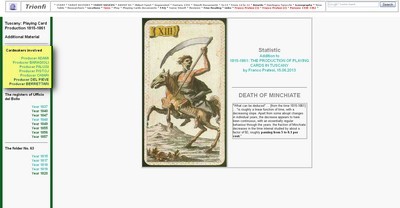
click it
|
ADAMI -
BARAGIOLI -
FALUGI -
PISTOJ -
CHIARI -
DEL PIEVE -
BERRETTARI
It is a seldom occurrence that a given cardmaker, or his family, is present for the whole time interval considered. This can be assumed for Adami and Baragioli; almost complete was also the activity of Falugi and Pistoj, but the presence of the remaining makers is only confirmed for a part of the time involved. In a few cases, it is hard to distinguish if the cardmaker was not active, or the corresponding records are missing.
2 - The registers of Ufficio del Bollo
Recently, I could find in the inventory compiled by Loredana Maccabruni another list of a whole sequence of official registers; namely, that of “Registri di Entrata per il Diritto di Bollo sulle Carte da Giuoco”, regularly compiled by the same “Ufficio del Bollo Straordinario e Azienda delle Carte da giuoco” and still preserved in the corresponding series, from N. 125 to N. 137.
These registers have again an official character, but are differently organised. Here we do not find separate pages for the different makers. On the contrary, the packs submitted to the stamping process in the offices are listed in a strict chronological order, independent of the cardmaker involved, with the sums at the end of the pages and monthly totals indicated both for packs and for the corresponding taxes.
This sequence is uniform and every volume continues the previous one, without any coincidence between the ends of the registers and the ends of months or years. In particular, we find four-months reviews for the taxes, but not for the packs. Clearly, it is the money amount involved and not the number of packs that is most important for the offices.
From the taxation point of view, there were only two groups of cards: Piccole, taxed 10s. independent of the number of cards, and Grandi, which – again independent of the number of cards – were taxed, exactly as for Minchiate, at 13s. 4d.
In checking this series, I have only examined the registers that could provide additional information to that derived from the series of the previous section; they are indicated in the following table.
Registri di entrata per il Diritto di Bollo sulle Carte da Giuoco
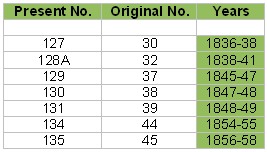
For these years, I have copied the monthly production as well, reported in the tables below.
1837 -
1840 -
1847 -
1848 -
1849 -
1855 -
1856 -
1857
3 - The folder No. 63
We have encountered two whole sequences of registers. Either of them should be suitable for reconstructing the complete production of playing cards in the course of the many years involved. I have mostly used the first of them, with the second mainly examined for adding the records that corresponded to a few missing registers of the first sequence.
There is however in the ASF at least a third item to mention, which may be useful. This time we are no longer in the presence of a whole sequence of registers; we have instead just one and only one archival piece.(5) It is a big folder containing many files and loose sheets of documents, collected orderly enough. There we essentially find the monthly records of stamp taxes, and also the records of stamped paper, which was controlled by the same office.
Let us neglect the records concerning stamped paper. For playing cards, we have yearly files with monthly sheets of records. The collection is not uniform through the years, and an evident limitation is that these documents only cover the years up to 1835.
As it occurred with the second item, I did not use this new source entirely. I have only copied some information for the first few years, which was less complete in the other books that I had examined.
The yearly production can be found below. Apart I have copied the monthly amounts for the same years, except for 1816. What is reported in the table above and in the monthly amounts inserted apart again corresponds to just a small part of the contents of the files preserved.
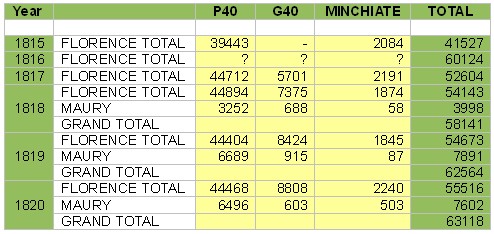
The card production for the whole of Tuscany was restricted to cardmakers active in Florence. As an exception, Luigi Maury was allowed to produce cards in Leghorn (= Livorno) to be used locally – his production was similarly controlled and recorded, but was kept as independent lists of records in the registers.
1815 -
1817 -
1818 -
1819 -
1820
It is noteworthy that here we have only 40-card packs – both Piccole and Grandi - and Minchiate. This probably corresponds to a simplification. The main interest of the offices was not to distinguish exactly the different kind of cards; their aim was to distinguish between cards that had different tax stamps. It is possible that by then a few 32- or 52-card packs were produced and considered by the office as if they were 40-card packs.
The production of Minchiate clearly had a secondary participation to the total production, but a similar consideration can be applied to the Grandi 40-card packs. At the time, it is evident that the Piccole format had already obtained a clear predominance among all the cards produced.
4 - Giving the numbers
Regrettably, I must admit that my copy of all these records is not fully reliable. The problem is that I am giving the numbers and whenever numbers are present one should have confidence in them, and feel sure to work with them on developing models, work hypotheses, or statistical derivations.
Now, there is an idiom in Italian, when we say “dare i numeri”, which has a meaning that cannot be verbatim understood as “to give the numbers”. No satisfactory equivalent expression exists in my dictionaries - English, nor French, nor German - that translate it as “to act a bit queer”, “battre la campagne”, or “unverständliches Zeug reden”.
Now, I fear that in part I am “giving the numbers” here, because to provide a perfect description, both complete and exact, I should now verify all these numbers again in the documents examined and confirm them on the basis of further documents, which are present in the archive.
In particular, I fear to have sometimes inserted the records in wrong columns, also because the presence of 32- and 52-card packs may have been differently recorded even in the original documents. In a few cases, we find different numbers in different kinds of official registers for the same year.
Summarising, it is evident that this information is not a qualitative one – it should be considered as quantitative. But I cannot encourage readers to use my numbers as if they were absolutely correct. If any researcher really wants to process these numbers, it would be better first to verify them in the original documents, before any working out.
Moreover, as already mentioned, the documents indicated above contain much more detail than has been deduced here. In other words, if this note has some value for future research, it will be likely be found more in the indication of the new documentary sources available than in the particular information reported here.
CONCLUSION
Many registers compiled by the official administration of Tuscany in the years 1815-1861 for controlling the stamp taxes of playing cards are still kept in the ASF. In particular, the main sources of our interest are two practically complete sequences of registers and a big folder with many files with monthly reports from 1815 to 1835, here described.
The information provided in these registers is extraordinarily abundant, probably more detailed than anybody could imagine. The production of every cardmaker can be followed practically day after day, pack after pack. The detail includes the sheets of watermarked paper initially given to cardmakers and their correspondence with the number of card packs produced, and with their stamp taxes.
I have selected and reported the data that appeared the most noteworthy. If anybody wishes to process this information, however, a new study of these sources is necessary, to amend any mistake that I likely made in copying, and to increase the quality and the quantity of this information, if useful.
Footnotes:
(1) Franco Pratesi: FLORENTINE CARD PRODUCTION IN ABOUT 1840, 18.11.2011
(2) Franco Pratesi: 1810-1811 – PLAYING CARDS IN LUCCA, 22.03.2013
(3) From ASF, Amministrazione Generale del Registro e Aziende riunite. Ufficio del Bollo Straordinario e Azienda delle Carte da giuoco, N. 162.
(4) From ASF, Amministrazione Generale del Registro e Aziende riunite. Ufficio del Bollo Straordinario e Azienda delle Carte da giuoco, N. 179.
(5) ASF, Amministrazione Generale del Registro e Aziende riunite. Direzione Generale di Firenze, N. 63.
| STILL IN WORK
Provisional Installation
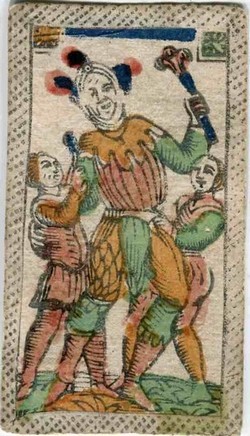
1815 - 1861
| "What can be deduced" ... [from the time 1815-1861] ... "is roughly a linear function of time, with a decreasing slope. Apart from some abrupt changes in individual years, the decrease appears to have been continuous, with an essentially regular behaviour through the years: the fraction of Minchiate decreases in the time interval studied by about a factor of 50, roughly passing from 5 to 0.1 per cent." |
From Napoleon ...
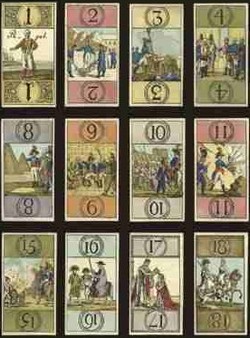
Napoleon Tarock by I.A. Herbert (1807)

Napoleon on Saint Helena
reached Helena in December 1815
... to Garibaldi ...
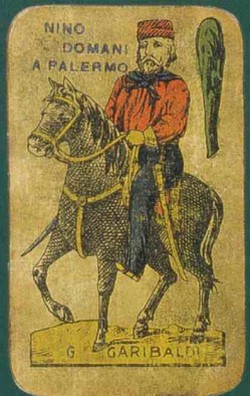
Playing card from Sicily
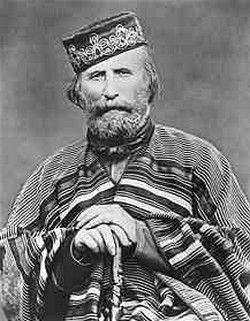
Giuseppe Garibaldi in 1866
.... and Italy
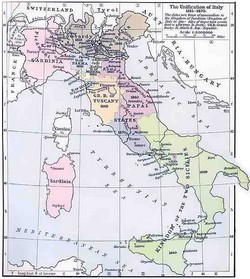
Unification to Kingdom of Italy (1861)
Dummett/McLeod statements
| (From the Minchiate chapter in A History of Games Played With the Tarot Pack, 2004)
"Minucci remarks" [1676] "that although it" [Minchiate] "is well known in Tuscany, elsewhere it is not much played, or at any rate played under different rules; he specifically mentions Liguria as region in which it is played differently, under the name Gallerini" (p. 324)
"It is evident that this game was highly regarded throughout the XVIIIth century, not only in Tuscany, but also in Rome, and it maintained its status into the early XIXth century. (p. 325)
Minchiate (as 'Gallerini') "died out in Sicily in the course of XVIIIth century, but it is in Genova, that it survived longest. In Florence its decline must have begun in the second half of the XIXth century: though packs were still being made there in the 1890s, the game was probably extinct soon after the end of the century; in Rome, no doubt, considerably earlier. The card firm of Solesio, in Genoa, on the other hand, was still producing Minchiate packs in the 1920s and 30s; in 1978 Stanley Gibbons sold a Solesio pack with an Italian tax stamp dated 1929, and in the 1930s Mr Martin Drayson of New York imported some Solesio packs for sale to playing card collectors. We should probably date the final demise of the game, in its Ligurian form, at around 1935." (p. 326) |
|
|














